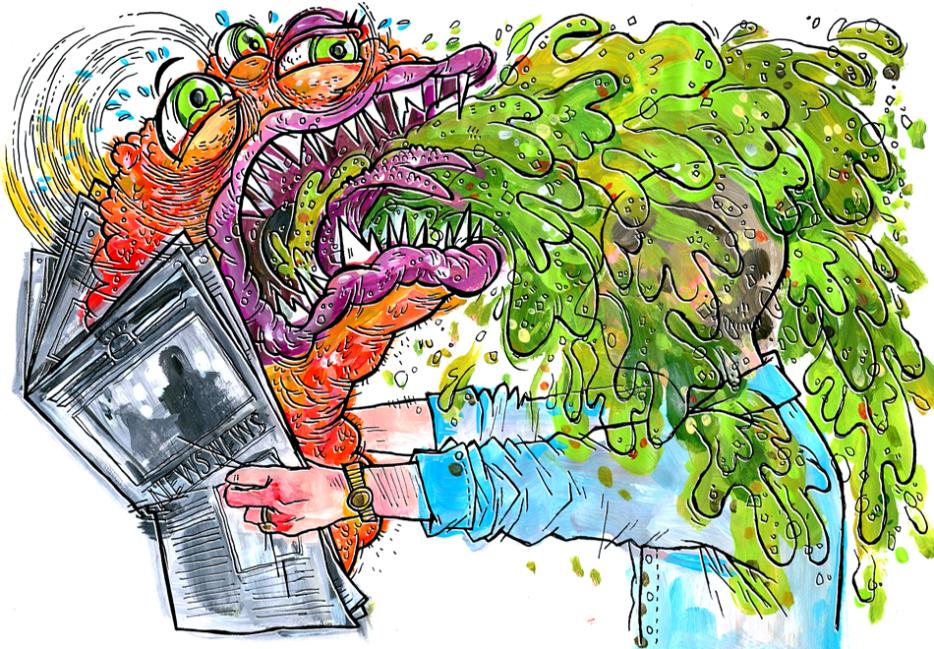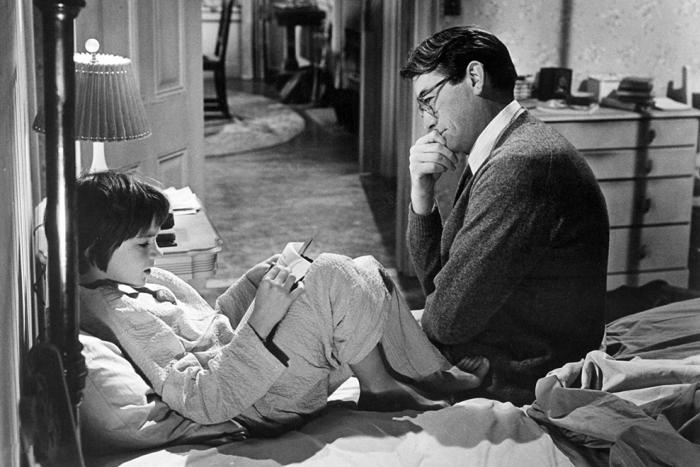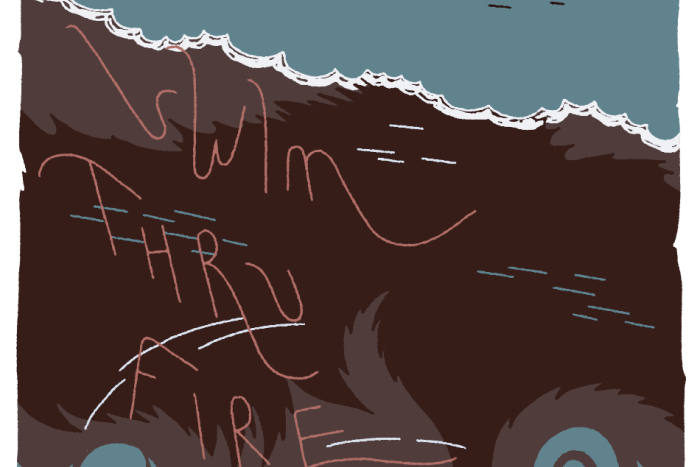Submit your questions for Scaach-22.
Every day, people write racist, bullshit things in The Globe and Mail and the National Post and the Toronto Star. Every day I think, Fuck those people, I'm never reading them again. But then someone tweets or Facebook-shares a link and I get tricked into reading more bullshit. Meanwhile, everyone is spouting off the importance of journalism, and all I can think is, holy fuck, journalism is, by and large and in the long run, hurting social progress. Am I wrong? Is my skin on too tight? Am I delusional?
Ooooooohhhhhohohohohoohohohoaaahhhhahahahaha, hooo boy. Okay. Well. You asked for it.
On Reporters (Or, Why You’re Not Delusional)
Here’s a bad idea: call a handful of working journalists, some at the big three you mentioned, some in media criticism, and ask each of them the question you posed to me. Record them as they sigh heavily, or chew the inside of their cheeks, or rub their eyes to stop the hot rush of I-feel-you tears, or just start laughing. Take this information, compress it into a little rage-diamond, and wear it around your neck like a medal of valor and/or your unbelievable depression.
Apologies and thanks to Sylvia Stead (The Globe and Mail), Jesse Brown (Canadaland), Matt Gurney (the National Post), Chantal Braganza (J-Source), Tim Falconer (The Ryerson Review of Journalism), and Kathy English (the Toronto Star), whom I enlisted to help answer your incredibly depressing yet familiar questions. Because, see, what you’re asking me, these questions about the value of the work being done, the frustration when you see it done poorly, and all the things between, are questions most journalists have already asked themselves. We meet up for drinks and peer into watered-down IPAs and try to justify our existence. Which is all to say: we’ve been over this.
It’s not surprising then, that when I asked people to go on the record about what we as journalists are doing right and what we’re doing wrong, they had a lot to say and yet, nothing I haven’t said myself over one pint or something or another.
“I don’t think distrust of the media is new,” says Kathy English, the public editor of the Toronto Star, the person who polices the police, of sorts, over at that paper. (The Globe’s public editor is Sylvia Stead. The Post doesn’t have one.) But if people are cynical about newspapers, “then how do every single one of us do our part to somehow push back against that?” English asks.
One thing’s for sure: it’s becoming more difficult to work in media and ignore the court of public opinion. Readers can be real vocal about their frustrations. Isn’t it nice that you can yell directly at writers and journalists when you disagree with them? It’s even better than the good old days, when you’d mail a writer an envelope filled with suspicious white powder. You’d think this would, in turn, make newspapers better. But unfortunately that’s not always how it works. Maybe because, with the volume turned up on every troll with an IP address, it can be hard to filter out the deserved criticism from the deranged. But you’re right in that there is a lot to deservedly criticize.
The results of shrinking ownership and budgets and mastheads, coupled with an institutional legacy of lilywhite bylines, are subconscious, quiet trespasses.
Take, for example, a recent piece in the Toronto Star. Lauren Pelley reported on gentrification in a Toronto neighbourhood. “For decades,” she wrote, “the neighbourhood was best known for being a seedy stretch along Bloor St. West from Lansdowne Ave. to Dufferin St., frequented by drug addicts and strippers.” The article, which lauded a selection of white business owners for bringing new life to the neighbourhood, was criticized online for inaccurately and disrespectfully portraying a diverse area.
Pelley declined to speak to me, but in her email reply said that “there really wasn’t much blowback” from the piece. This, to me, feels dismissive, which is problematic in and of itself, but the whole incident is a good illustration of a lack of accountability and scope that often presents itself when most of the newspapers in a country are run by an ever-shrinking number of large corporations on skeleton budgets playing a game of hot potato in which the potato is “who will fold first?” Pelley, a one-year intern for the Star, was likely sent on assignment and expected to return with a fairly predictable story that her editors wanted. I’ve been sent on this kind of assignment, countless times, to a part of the city I don’t know well, asked to come back with a piece that, inevitably, won’t be the full story, about people whose complex histories I will never be able to truly grasp. Articles like this end up in the newspaper all the time and frustrate the communities they touch, and the reason they end up going to print is that a lack of diversity in newsrooms will inevitably lead to tone-deaf pieces that have little oversight.
Chantal Braganza is the associate editor at J-Source, which offers research and commentary on Canadian media, mostly as a resource for journalists. “There are definitely instances where papers drop the ball,” she says. “The language that you use in reporting on a Somali community, for example, is a form of the way racism works, even if no one actively thinks that they’re doing anything wrong … Something as simple as looking for people to staff your newsroom who might be better attuned to what it is that you’re covering, that you don’t get right or often drop the ball on, would really help,” Braganza says. Newsrooms are overwhelmingly staffed with white people, largely white men, largely cis, straight white men. Let’s take a look at the editors-in-chief of a handful of Canadian newspapers: the National Post, the Globe and Mail, the Toronto Star, the Calgary Herald, the Calgary Sun, the Montreal Gazette, the Edmonton Journal, The Province, the Ottawa Citizen, the Winnipeg Free Press, the Hamilton Spectator, La Presse, the Chronicle-Herald, the Nunatsiaq News, the Toronto Sun, and the Leader-Post. Four are women. Two are people of colour. (One of them is from my hometown! How ‘bout that?) As Matt Gurney, columnist, Deputy Comment section editor at the National Post, and straight white man, says, “I do not consider myself particularly representative of the broader Toronto population. I’m certainly representative enough of the broader Toronto media landscape. I’m a generic white dude, there’s no denying that.”
Hiring more people of colour in Canadian newsrooms will help soothe some of the problems you’re having when you read the paper. I don’t think any reporters (reporters being the key word) in Canada can get away with being blatantly racist, but I do think the structure of most news organizations still allows often-subconscious biases to seep into their work without anyone in charge noticing. Do I expect a white reporter to be familiar with every intricacy of Indian culture? No. Do I think whiteness prevents a reporter from writing about a community they’re unfamiliar with? Of course not, but there’s a lack of education about how to enter those communities without acting like a voyeur or a white saviour or otherwise ignoring the history that came before you showed up with your notebook. I guarantee that, had a brown person talked to Lee Dares about her truly moronic ghee business, the piece would have come out differently than what ended up running in the Toronto Star.
The issue, however, isn’t just that the people in the newsroom aren’t diverse enough. Yes, the results of shrinking ownership and budgets and mastheads, coupled with an institutional legacy of lilywhite bylines, are subconscious, quiet trespasses, but there are also simply not enough people in the newsroom, period. Journalism is expensive. Newspapers are hemorrhaging money. “The last provincial election ... that was the first time to me I began to really see the impact of all the cutbacks the media’s been through the last couple of years,” says Gurney. Overworked reporters have to tweet and take video and photos and basically kill themselves to bring you Fresh Content™. No wonder so much of it is failing you. It’s by no means an excuse, but it is a reality. There was a time when one could have argued journalism suffered from a problem of availability or distribution, with the 5 p.m. news or the morning paper being some of the few ways to get information across to anyone. Now, it’s easier than ever to get access to once-unsearchable information, to present it to the public in the age of “What Is Code?” The downside is that we just don’t have the personpower to do the job the way we want to. “If I’m the public, I wouldn’t be worried that you’re being lied to, or that I’m trying to sell art to the people I interview, or that I’m bad-touching the interns,” Gurney says. “I’m just worried that maybe there’s a lot more out there that the newspapers do not have the ability to cover anymore, because there aren’t enough bodies on the ground.”
On Columnists (Or, Why This Is Sort Of Your Fault Too)
Jesse Brown, Adult Spitball Hurled From Back Of Class, started the Canadaland podcast and website as a media watchdog and/or Canadian ombudsman and/or tabloid. He manages to do some of the best and worst media reporting in the country, and sometimes he invites me to join him and I end up screaming for 25 minutes and then have to do an hour of karmic exercise to realign my chakras. (This is what I call drinking.) It’s also some of the only reader-facing media reporting in the country.
“I think that every newspaper and media source has an idea of who their audience is,” he says. “I think that without exception, in the mainstream media, that perceived audience is a middle-aged white man. So what we read from our columnists are, with exceptions, but by and large, opinions that gratify the biases and status and position of middle-aged white men in Canada.”
The rules are different, just as they are when you’re driving a golf cart instead of a real car. One is for funsies; the other can literally kill someone.
Are you a man? Are you white? Are you old? Do you lean towards conservatism? Do you feel bad for Stephen Harper? If you answered no to any of these, that's probably a good starting point as to why you get mad reading the newspaper. Take a look at the National Post’s Comment section online. There are 19 names listed and they are, predictably, overwhelmingly white and male. Does that represent the world you live in, the world you want? When you read the columns and op-eds in the National Post, do you feel remotely represented?
I know I’m in a media bubble myself, so there’s another distinction necessary to make for people who do not work for a newspaper/magazine/Internet content loaf-cutter. A columnist is not necessarily a journalist. At their best, a columnist is someone who can turn a nice phrase and has Opinions on Varied Things and is both Engaging and Infuriating. At their worst, they are bioengineered dragon-babies whose only purpose on this planet is to set you aflame. They work in media, yes, and their desks are often cozied up to the beat reporters and copy editors, but they are also in a class of their own.
The context of their work matters, which is why it’s so important that columns are labeled properly (particularly online), because yes, there are people whose opinions are swayed by the junk they read in the paper, and people who are unaware that different forms of journalism (newspaper reporting, columns, magazine writing) adhere to different sets of ethics. When I write this here advice COLUMN, for example, I am not the journalist who, in the past, has brought you painstakingly researched hot scoops, but rather, a columnist who just happens to be insanely hot. The rules are different, just as they are when you’re driving a golf cart instead of a real car. One is for funsies; the other can literally kill someone.
I suspect that the things making you the angriest about the big three newspapers are written by the columnists, because that is their job. Of course you’re going to get angry if you look at these journalists as anything other than human beings, some of whom, yes, you sweet dumb baby, earn their ever-more-contested paycheques baiting you into reading their trash by writing uncomplicated, condescending, insulting drivel. You’re talking about the big three—and despite layoffs, they’re still pretty big—so you’ll have to take the good (more on that later) with the bad.
News outlets hire inflammatory columnists like the ones who are making you so mad largely for two reasons: because everyone will agree with them and cheer them on, or people will viscerally disagree with them and come a-traipsing up the front steps of the Toronto Star, calling for death. In either case, the public logic is that writers are there to start conversations.
“We do want to actually get people talking,” Gurney says. “I will print stuff that I absolutely disagree with if I think it’s an interesting argument that people will want to talk about.” But in reality, the columns that really gather ire aren’t so much conversation-starters as they are unhinged meditations on (often) controversial topics. Margaret Wente’s most recent column in the Globe and Mail, for example, was literally about what women can learn from men. I refuse to believe her editor wasn’t tenting his or her fingers together and maniacally laughing as pageviews rolled in. “Every once in a while I run something because I know it’s going to piss a lot of people off," Gurney says. "I won’t run it if I think it’s literally racist or libelous, but every once in a while ... I’ve got a fairly calm piece on tax reform policy, or I have a fucking hand grenade that’s going to go off and infuriate people.” (But Gurney, I’d like to specify again, is a white guy, far less likely to be offended by a negative column about, say, women or the LGBTQ community or immigrants or trans people or anyone with an unpronounceable name, NOT THAT I KNOW ANYTHING ABOUT THAT.)
The public line might be that columns help newspapers facilitate public conversations, but do you know what else it’s about? Money. Because here’s the other thing about traditional print media: they need money. Oh god, they need money. Now more than ever before, public response is essential for newspapers to stay alive, and it’s human nature to share something you hate before something you love. Page views are the racket. When you click that link, you are indeed rewarding a child for bad behavior. Why do you think there are websites that exist that allow you to read the work of infuriating columnists without contributing to their search engine strength?
So by reading this stuff, you are indeed making the problem worse. But sometimes you just can’t help it! A hate read is supremely satisfying, particularly when you don’t just hate what was written but who wrote it. So the first thing you need to do is relinquish the idea of never reading anything inflammatory or upsetting again. You will! Of course you will. You’re human, and columns that run off the exhaust of rage and fury will inevitably interest you at your most base desires. People like disagreeing. It’s enjoyable to get mad. It’s okay to lean into it sometimes. But know your limits. Are you becoming this enraged every time you read something by any columnist you disagree with? Do you keep reading it even though you’re not even enjoying the delight of getting outraged? Then maybe go outside and do something else, literally anything besides peering into the emptiness of your browser, trying to find meaning in something that was only ever conceived to make you mad.
The trouble, though, is that while there’s certainly a technical line between fair commentary and offensive commentary—Kathy English is quick to remind us that freedom of speech is important, and it is—there isn’t, say, a moral line.
Then maybe go outside and do something else, literally anything besides peering into the emptiness of your browser, trying to find meaning in something that was only ever conceived to make you mad.
I think that if someone like Wente didn’t make people so goddamn angry that they felt compelled to share her pieces widely, annotated with little rage-emojis, she would not have the job she does. Media outlets are companies, and companies would like to make money and stay afloat. If she didn’t make people mad, if she wasn’t the voice of the unreasonable, if she didn’t play Devil’s Advocate when even the devil might say, “ha ha, no thank you,” she would not have a job.
But Brown disagrees. “I don’t think that [mainstream newspapers] keep people like Wente around either because she has a fanbase or either because she’s an effective troll. She’s a member of the establishment. I think there’s a very strong sense of us-and-them and she is a lifer, she is a Globe and Mail senior, senior person, who is protected at the expense of that paper, at the expense of the credibility of everyone who works there.”
Now What? (Or, “You Gotta Go On, Chicken, You Gotta Go On In Life”)
The biggest issue the media has, aside from losing staff and money and all those little nuisances, is the public's lack of media literacy—not that you can necessarily blame them. No one does a good enough job explaining to people how news is gathered and presented, no one explains how personal biases get in the way, no one gets into how the institution has been fucked from the beginning and will, therefore, likely fuck you. I don’t have an answer to fix this. How media literate are you? How much do you read? How closely do you read?
But your question is deeper than that: you want to know if journalism is hurting society, if it’s setting us back, if it’s making things worse. Mainstream media coverage stands for a small fraction of the country. I don’t think it actually represents what people think, how they act, what they want—unless you happen to be the target audience of said media, which by the sounds of it, you and your ilk are not.
Journalism is a living thing that can encompass reporting or research or the odd impassioned screed. Journalism does good things because it teaches the public about the world they live in, the parts they had no idea about, the parts they thought they knew so well. I believe in journalism. No one goes into journalism because they think it’s useless. None of us came here for the money. We all, at one point or another, wanted to make things better.
“Don’t just read one newspaper, read it all, compare, figure out what you think is right,” English says. “Please don’t give up on us.” As Braganza reminds us, while newspapers may publish racist, sexist columnists, they can also influence policy change or shine a light on issues like sexual assault and workplace harassment.
Would we have reelected Rob Ford had the Toronto Star not repeatedly reminded us he was an asshole? What would have been done for the victims of thalidomide had the Globe not reported on it? And had Jesse Brown not exposed Jian Ghomeshi, would we still be pretending he was the CBC’s greatest asset?
So fill your Pocket with better things. If you want to read The Globe and Mail and the Toronto Star and the National Post, Tabatha Southey is a good standby for a larf, Denise Balkissoon is great on culture and race and urban affairs, Ishmael Daro is an excellent troll and an excellent writer, and Ed Keenan is often just about all you need for local Toronto commentary (except maybe for his recent piece about the murderous Queen’s Quay, but you can’t win ‘em all).
And hey, are you reading Hazlitt regularly? We are here, we are Canadian, we aspire to not make you feel so hopeless. Not a plug, of course, just a columnist expressing an opinion, is all.
Oh, and, if you aren’t already—do not read the comments. I don’t think your feeble heart could take it.






